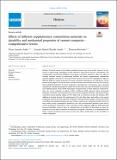Effects of different supplementary cementitious materials on durability and mechanical properties of cement composite – Comprehensive review
Abstract
Ordinary Portland cement is the highest produced cement type in the world, however its pro-
duction is high energy consumption means expensive, huge natural resource consumptive, and
creating high environmental pollution. Hence many researchers studied to reduce the effect of
ordinary Portland cement by substituting artificial and natural supplementary cementitious
materials (SCMs) commonly in a concrete/mortar mixture. However, the comprehensive effect of
different SCMs on various properties of cement composite materials are not well known. So the
present study sought to review the effect of different natural and artificial SCMs on the durability
and mechanical properties of cement composites, especially due to their doses, types, chemical
composition, and physical properties. Hence the review shows that many SCMs used by literatures
from different places satisfy ASTM replacement standard based on their chemical compositions.
Also, the review indicated as adding 5–20% of different SCMs positively affect mechanical
properties, durability, and microstructures of the cement composite materials, specifically as most
researchers found isolately adding of 15% SCMs such as bentonite, kaolin, and biomass, 20%
addition of volcanic ash and 10% employment of fly ash, silica fume, and zeolite to the cement
composites achieves the most optimum compressive and split tensile strength. These observations
reveal that most natural pozzolana can more replace cement to give optimum strength, hence can
more reduce energy consumption, production cost, and environmental pollution comes due to
cement production. Furthermore, most researchers found employing different SCMs generally
improves durability, however there is a limited study on the effect of silica fume on water ab-
sorption and acidic attack resistance of cementitious materials. Therefore, it is recommended that
future research should also focus more to know the effect of silica fume on the durability of
cement composites.
URI
https://doi.org/10.1016/j.heliyon.2023.e17924https://dspace.nm-aist.ac.tz/handle/20.500.12479/2106

